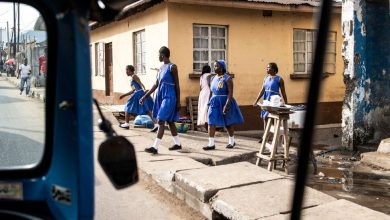The Drive to Vaccinate the World Against Covid Is Losing Steam

In the middle of last year, the World Health Organization began promoting an ambitious goal, one it said was essential for ending the pandemic: fully vaccinate 70 percent of the population in every country against Covid-19 by June 2022.
Now, it is clear that the world will fall far short of that target by the deadline. And there is a growing sense of resignation among public health experts that high Covid vaccination coverage may never be achieved in most lower-income countries, as badly needed funding from the United States dries up and both governments and donors turn to other priorities.
“The reality is that there is a loss of momentum,” said Dr. Isaac Adewole, a former health minister of Nigeria who now serves as a consultant for the Africa Centers for Disease Control and Prevention.
Only a few of the world’s 82 poorest countries — including Bangladesh, Bhutan, Cambodia and Nepal — have reached the 70 percent vaccination threshold. Many are under 20 percent, according to data compiled from government sources by the Our World in Data project at the University of Oxford.
By comparison, about two-thirds of the world’s richest countries have reached 70 percent. (The United States is at 66 percent.)
The consequences of giving up on achieving high vaccination coverage worldwide could prove severe. Public health experts say that abandoning the global effort could lead to the emergence of dangerous new variants that would threaten the world’s precarious efforts to live with the virus.
“This pandemic is not over yet — far from it — and it’s imperative that countries use the doses available to them to protect as much of their population as possible,” said Dr. Seth Berkeley, chief executive of Gavi, the nonprofit that runs the global vaccine clearinghouse Covax.
Countries in different parts of the world, including some in Eastern Europe and the Middle East, have seen their vaccination rates stagnate in recent months at a third or less of their populations. But Africa’s vaccination rate remain the most dismal.
Fewer than 17 percent of Africans have received a primary Covid immunization. Nearly half of the vaccine doses delivered to the continent thus far have gone unused. Last month, the number of doses injected on the continent fell by 35 percent compared to February. W.H.O. officials attributed the drop to mass vaccination pushes being replaced by smaller-scale campaigns in several countries.
Some global health experts say the world missed a prime opportunity last year to provide vaccines to lower-income countries, when the public was more fearful of Covid and motivated to get vaccinated.
“There was a time people were very desperate to get vaccinated, but the vaccines were not there. And then they realized that without the vaccination, they didn’t die,” said Dr. Adewole, who wants to see countries continue to pursue the 70 percent target.
What momentum remains in the global vaccination campaign has been hindered by a shortfall in funding for the equipment, transportation and personnel needed to get shots into arms.
In the United States, a key funder of the vaccination effort, lawmakers stripped $5 billion meant for global pandemic aid from the coronavirus response package that is expected to come up for a vote in the next few weeks. Biden administration officials have said that without the funds, they will be unable to provide support for vaccine delivery to more than 20 under-vaccinated countries.
Some public health experts point to reasons for optimism that the global vaccination campaign still has steam. Despite the drop off from the February peak, the number of Covid vaccinations being administered each day in Africa is still near a pandemic high. And Gavi earlier this month drew a significant new round of funding pledges, securing $4.8 billion in commitments, although it fell short of its $5.2 billion goal.
There is also hope that a global Covid summit the White House plans to co-host next month could be an opportunity to generate momentum and funding.
But the drop in public demand has led some health officials and experts to quietly, and in some cases outright, question whether the 70 percent vaccination target is feasible or even sensible.
Reported fatalities from Covid-19 remain comparatively low in sub-Saharan Africa, although there is debate about how much of this reflects poor data tracking. The perception, however, in many countries in the region is that the disease does not pose a serious threat, certainly not as much as other pervasive health problems that demand attention with scarce health care resources.
Many lower-income governments are turning their focus to their economies and other health issues like H.I.V., said Fifa Rahman, a civil society representative to a W.H.O.-launched group coordinating the global Covid response. “There’s a sense of a lot of competing priorities, but that’s a symptom of the momentum being gone. Because when the momentum was there, everyone was like, ‘Where are our vaccines?’”
In rural areas of the Democratic Republic of Congo, for example, where the reported Covid death rate is very low, there is a surge in measles cases threatening 20 million children. Yet the government says it cannot spare the resources to provide supplementary measles vaccinations this year, said Christopher Mambula, medical manager for Doctors Without Border in East Africa. In this kind of context, it makes little sense to continue to divert resources to widespread vaccination against Covid, he said.
As African governments have received more vaccines donated from wealthy countries and struggled to distribute even those supplies, their interest in ordering more doses has dropped.
The African Union still aims to vaccinate 70 percent of its population by the end of 2022. But with countries slow to use up donated vaccines, the bloc has not exercised its options to order more doses of the shots from Johnson & Johnson and Moderna.
The South African drugmaker Aspen Pharmacare earlier this year finalized a deal to bottle and market the Johnson & Johnson vaccine across Africa, a contract that was billed as an early step toward Africa’s development of a robust vaccine production industry. Aspen geared up for production, but no buyers, including the African Union and Covax, have placed orders yet, said Stephen Saad, Aspen’s chief executive.
The Serum Institute of India, the world’s largest vaccine maker, stopped its production of Covid shots in December last year, when its stockpile grew to 200 million doses; Bharat Biotech, another Indian firm that was a major producer also stopped making vaccine in the face of low demand. The companies say they have no further orders since their contracts with the Indian government ended in March.
After the W.H.O. began promoting the 70 percent vaccination goal, many lower-income governments adopted the target for their own populations. The Biden administration also endorsed it last September, setting a deadline of September 2022.
At the time, two doses of the vaccines from Pfizer and Moderna were understood to offer very strong protection against even mild disease, and there was still hope that achieving high levels of vaccination coverage would tame the virus. But the emergence of new variants and the spread of the virus in Africa changed the calculus.
The vaccine regimens that had been planned for the developing world offered little protection against infection with the Omicron variant. And as sub-Saharan African countries were shut out of vaccine distribution for much of last year, more and more Africans gained protection against the virus from natural infection, which studies have shown works as well as two mRNA doses in preventing infection. New data from the W.H.O. shows that at least two-thirds of Africans had been infected with the virus before the Omicron wave.
Given these factors, some public health experts in Africa say the broad 70 percent goal no longer makes sense. “There’s very little value to it. In fact, we will gain much more by getting to more than 90 percent of people above the age of 50,” said Shabir Madhi, a professor of vaccinology and the dean of the faculty of health sciences at the University of the Witwatersrand in Johannesburg. About two-thirds of South Africans above age 50 are currently fully vaccinated.
Dr. Madhi said that South Africa could close down mass vaccination sites and instead redouble its efforts to seek out the most vulnerable at church services and at government offices that pay out monthly pension benefits.
Katherine O’Brien, who directs the W.H.O.’s work on vaccines and immunizations, said the agency encourages countries to focus on its most vulnerable citizens rather than vaccinating “a random set of 70 percent” of their populations. The aspiration she said, has always been “100 percent of health workers, 100 percent of older adults, 100 percent of pregnant women, 100 percent of the people who fall into those highest risk groups.”
Countries can of course make decisions about what health goal they wish to prioritize, Dr. O’Brien said, but finite resources should not be the obstacle to vaccinating against the coronavirus. “The world has enough resources to do this, if countries want to do it,” she said. “And that should be really the North Star.”
Some public health experts said that while the 70 percent vaccination threshold is clearly not achievable by its original deadline, it would be unwise and unethical to give up on that target over a longer time horizon. They expressed frustration about the growing gulf between wealthy countries vaccinating young children and offering healthy adults fourth vaccine doses, and the regions where the majority of people still do not have one dose.
“Why are we making it one target for high-income countries and one target for low income?” said Dr. Ayoade Alakija, a co-chair of the African Union’s vaccine delivery program.
She said that even though many people in sub-Saharan Africa have been infected, there is still need for the additional protection that would come from a high level of vaccination coverage.
Modest vaccination coverage, she said, “is not considered a good enough level of protection in England, it’s not a good enough level of protection in America. How is it OK not to be aiming for the very maximum, maximum we can? Aim for the sky and get to the top of the tree.”




